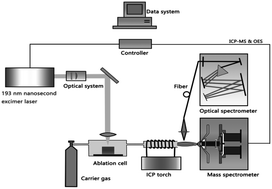Nanosecond laser ablation tandem inductively coupled plasma mass and optical emission spectrometry for micro-chemical elemental analysis†
Abstract
A novel experimental system was designed for micro-chemical elemental analysis using a laser ablation technique tandem to both mass and optical emission spectrometry. One new excimer gas laser of 193 nanometer wavelength was constructed to replace the COMPexPro 102 laser unit in the RESOlution M50 laser ablation system without changing the ablation cell. The ablated mass (aerosol) was introduced into the inductively coupled plasma mass spectrometer, i.e. Agilent 7500, where optical emission spectrometry was performed simultaneously using an Ocean Optics fiber optic spectrometer. The fiber optic spectrometer consists of six channels, which can detect the optical emission lines from plasma and cover wavelengths from 190 nm to 800 nm. Standard reference materials were measured for demonstrating the elemental analytical method. The constant LA-ICP-MS transient signals, acceptable concentration determinations of MPI DING glass ATHO or T1 samples and negligible differences of elemental fractionation due to replacement of the laser source in RESOlution M-50 suggest that our newly constructed excimer gas laser can satisfy LA-ICP-MS micro-chemical analysis. Furthermore, the laser ablated particle resultant inductively coupled plasma optical emission lines can be identified, and the quite good linear correlation of signals in various emission lines of the same element analysed suggests that the wavelength resolution necessary for quantitative elemental analysis by LA-ICP-OES can be achievable using a fiber optic spectrometer. Finally, based on sharing the same inductively coupled plasma configuration in our new LA-ICP-MS & OES system, the linear correlation between signals of LA-ICP-MS and LA-ICP-OES for the same elements can be recognized. The calibration curves for optical emission lines of element manganese, and the coefficient ratios around 0.999, suggest that the novel method of LA-ICP-MS & OES might be a feasible option for micro-chemical elemental analysis through synchronously detecting the stoichiometric composition in the laser ablated mass resultant inductively coupled plasma.



 Please wait while we load your content...
Please wait while we load your content...